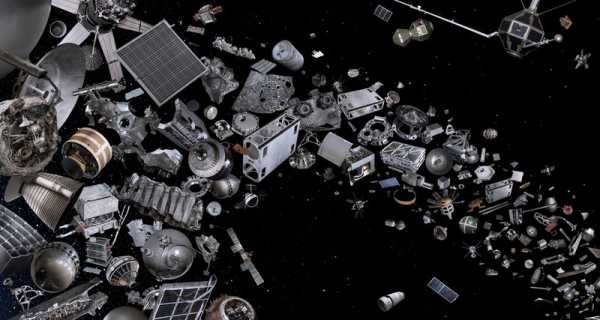
In November 2021, astronauts aboard the International Space Station were forced to take evasive measures to avoid debris created by the intentional destruction of a satellite by a Russian missile (Photo: Green Party)
In February 2009, a Russian military satellite travelling at more than 42,000km per hour smashed into a US communications satellite.
Both satellites were instantly destroyed, shattering into tens of thousands of fragments. It was the first-ever in-orbit collision between two satellites. However, it is an event that could become increasingly common as humanity exponentially increases our activities in space.
In 2009, there were less than 1,000 active satellites in orbit. By 2030, there could be 100,000. This is due to the launch of mega-constellations of satellites by companies such as SpaceX and Amazon. Low-Earth orbits are becoming dangerously congested with larger and larger objects and increasing lethal debris. Both the European Space Agency and NASA have raised the alarm.
The collision in 2009, created thousands of pieces of debris of more than 10cm in diameter and many times that number of smaller debris travelling at speeds of up to 7km per second that cannot be tracked or avoided and can be can just as deadly when it collides with a satellite.
At these speeds, even a fleck of paint can cause critical damage to space infrastructure. In November 2021, astronauts aboard the International Space Station were forced to take evasive measures to avoid debris created by the intentional destruction of a satellite by a Russian missile.
For years researchers have been sounding the alarm about the dangers of increasing space debris. In 1978, NASA scientist Donald Kessler outlined what could happen if a collision occurred in an over congested orbit.
Debris from the initial collision could produce many orbiting fragments, each one increasing the possibility of further collisions, ultimately this could spark a chain reaction that makies entire orbits unusable for generations.
Not only would this pose a huge risk to spacecraft and astronauts but vital services such as weather forecasting, climate monitoring, and internet connectivity could be lost.
If there is one lesson to draw from recent years, it is that seemingly unimaginable events can quickly become a reality, with devastating consequences. Growing congestion in low-earth orbit is not just increasing the risk of collisions, researchers and space agencies also are increasingly concerned about adverse effects on astronomy, the night sky, the atmosphere, and even earth defences against asteroid impacts. This damage is being driven by a handful of companies attempting to monopolize what should be a great shared resource.
We urgently need to act to curtail unduly risky behaviour and monopolisation of our orbital resources. Current space laws are no-longer fit for purpose, being designed for a period when companies were launching only a handful of satellites.
Ideally new rules would be developed at the global level under the auspices of the United Nations or the International Telecommunication Union. However, building any kind of global consensus in the near term seems impossible.
Space shouldn’t be the new Wild West
Just as Europe has led on environmental matters on earth, we must do the same in space. The European Union and its member states have the tools in place to prevent space from developing as a Wild West or the dominion of just a few.
The initial priority must be to understand what level of activity our orbital respources can sustainably handle. We took this approach for civilian air traffic; we should do the same for low-earth orbits. The European Space Agency and Europe’s many leading universities are well-placed to do this, in close collaboration with private companies.
European and national regulators should then use the power of Europe’s single market to force all companies to act responsibly. Regulators should set clear conditions when granting market access to lower the risk of collisions and the creation of debris, as well as ensuring shared access to limited orbital resources.
This would push companies and other jurisdictions such as the U.S. to also modify their response. The upcoming European Space Law is a great opportunity for Europe to take the lead. Standards set in Europe could then become the model worldwide. Getting this right matters because space is increasingly vital to all aspects of our lives.
Sign up for EUobserver’s daily newsletter
All the stories we publish, sent at 7.30 AM.
By signing up, you agree to our Terms of Use and Privacy Policy.
From increased connectivity to tackling global challenges such as climate change, the new space age offers a wealth of opportunities. However, these will only be realised if activities in our orbits are sustainable. Humanity has a bad track record in correcting damaging behaviour. Too often we only react after disaster occurs or the consequences of our actions are irreversible.
On earth we are playing catch-up, trying to mitigate the damage of climate change and clean up islands of plastic in our oceans. In space, the issues are playing out at an even more accelerated pace. We could go from very little material risk to the saturation of orbits closest to earth within this decade.
Right now, we still have a window of opportunity to act but it is quickly closing. We must urgently set clear rules to prevent destructive behaviour, so we don’t squander yet another of earth’s great resources. If we fail to do so we risk cutting off the vast possibilities of space for generations to come.
Source: euobserver.com



